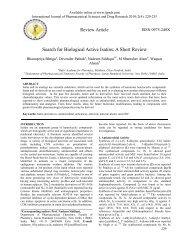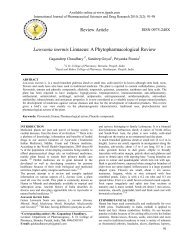In vitro Anthelmintic Activity of Aerial Parts of Aerva lanata Linn Juss
In vitro Anthelmintic Activity of Aerial Parts of Aerva lanata Linn Juss
In vitro Anthelmintic Activity of Aerial Parts of Aerva lanata Linn Juss
Create successful ePaper yourself
Turn your PDF publications into a flip-book with our unique Google optimized e-Paper software.
Available online at www.ijpsdr.com<strong>In</strong>ternational Journal <strong>of</strong> Pharmaceutical Sciences and Drug Research 2010; 2(4): 269-271Research Article ISSN 0975-248X<strong>In</strong> <strong>vitro</strong> <strong>Anthelmintic</strong> <strong>Activity</strong> <strong>of</strong> <strong>Aerial</strong> <strong>Parts</strong> <strong>of</strong> <strong>Aerva</strong> <strong>lanata</strong> <strong>Linn</strong> <strong>Juss</strong>Rajesh R 1* , Chitra K 2 , Padmaa M. Paarakh 31 Dept <strong>of</strong> Pharmaceutical Chemistry, The Oxford College <strong>of</strong> Pharmacy, Hongasandra, Bangalore- 68, Karnataka, <strong>In</strong>dia2 Sri Ramachandra College <strong>of</strong> Pharmacy, Sri Ramachandra University, Porur, Chennai- 600116, Tamil Nadu, <strong>In</strong>dia3 Dept <strong>of</strong> Pharmacognosy, The Oxford College <strong>of</strong> Pharmacy, Hongasandra, Bangalore- 68, Karnataka, <strong>In</strong>diaABSTRACTMethanol and aqueous extracts <strong>of</strong> <strong>Aerva</strong> <strong>lanata</strong> <strong>Linn</strong> <strong>Juss</strong> were taken for anthelmintic activity against <strong>In</strong>dian earthwormPheritima postuma. Various concentrations <strong>of</strong> both extracts were tested and results were expressed in terms <strong>of</strong> time forparalysis and time taken for death <strong>of</strong> worms. Piperazine citrate (10 mg/ml) was used as reference standard and normalsaline as a control group. Dose dependent activity was observed in both the extracts and the result shows that the methanolextract possesses more activity than aqueous extract and thus may be useful as an anthelmintic.Keywords: <strong>Anthelmintic</strong>, <strong>Aerva</strong> <strong>lanata</strong> <strong>Linn</strong> <strong>Juss</strong>, Piperazine citrate.INTRODUCTIONThe World health Organisation (WHO) estimated that 80%<strong>of</strong> the population <strong>of</strong> developing countries rely on traditionalmedicines, mostly plant drugs for their primary health careneeds. The use <strong>of</strong> medicinal plant is growing worldwidebecause <strong>of</strong> the increasing toxicity and allergic manifestations<strong>of</strong> the synthetic drugs. Helminth infections are among themost common infections in man, affecting a large proportion<strong>of</strong> the world’s population. <strong>Aerva</strong> <strong>lanata</strong> <strong>Linn</strong> <strong>Juss</strong>(Amaranthaceae) is known as Polpala. The prostrate todecumbent, sometimes erect herb, 30-60 cm in height, wolly,tomentose through out. The plant is distributed throughouttropical <strong>In</strong>dia as a common weed in fields and wasteland andis also found to be grown in Arabia, Tropical Africa, Srilanka, Phillipine and Java. [1] It is commonly known as Chaya(Hindi), Sirupulai (Tamil) and Bhadra (Sanskrit). [2] <strong>In</strong> thetraditional system <strong>of</strong> medicine, the plant was used as diuretic[3] , anthelmintic[4] , anti-inflammatory[5] , diuretic [6] ,urolithiasis[7] , nephro protective action in rats[8] ,antimicrobial activity and cytotoxicity <strong>of</strong> <strong>Aerva</strong> <strong>lanata</strong>. [9]The aerial parts <strong>of</strong> <strong>Aerva</strong> <strong>lanata</strong> used as anthelmintictraditionally. Literature survey reveals that there are noreports on systematic and scientific study <strong>of</strong> anthelminticactivity <strong>of</strong> has been reported, an attempt has been made toevaluate the anthelmintic potential <strong>of</strong> aerial parts <strong>of</strong> <strong>Aerva</strong><strong>lanata</strong>.MATERIALS AND METHODS*Corresponding author: Mr. Rajesh R,Dept <strong>of</strong> Pharmaceutical Chemistry, The Oxford College <strong>of</strong>Pharmacy, Hongasandra, Bangalore- 68, Karnataka, <strong>In</strong>dia;E-mail: rajeshsrn@gmail.comCollection and authentication <strong>of</strong> plant material plantmaterialFresh aerial parts <strong>of</strong> the plant <strong>Aerva</strong> <strong>lanata</strong> <strong>Linn</strong> <strong>Juss</strong> werecollected from Tirunelveli district in Tamil Nadu, <strong>In</strong>diaduring the month <strong>of</strong> November and it is identified andauthenticated by Dr. Shiddamallayya N, Asst. Director<strong>In</strong>charge from Regional Research <strong>In</strong>stitute (AY), Bangaloreand Voucher specimens (RRCBI- 5588) was deposited in theinstitute. The aerial parts <strong>of</strong> <strong>Aerva</strong> <strong>lanata</strong> <strong>Linn</strong> <strong>Juss</strong> weredried in the shade and it is milled into coarse powder by amechanical grinder and it is stored in closed vessel for furtheruse.Drug and chemicalsThe drug piperazine citrate (Glaxo SmithklinePharmaceutical Ltd.) purchased from commercial sourcesand all other chemicals were <strong>of</strong> analytical grade.Preparation <strong>of</strong> ExtractThe air dried coarse powder <strong>of</strong> the aerial parts <strong>of</strong> <strong>Aerva</strong><strong>lanata</strong> was extracted successively with organic solvents <strong>of</strong>increasing polarity like petroleum ether, chlor<strong>of</strong>orm, acetoneand methanol using soxhlet’s apparatus and water bymaceration for 7 days. Each time before extracting with nextsolvent, the marc was dried in the air and it is then repackedin the apparatus. After each extraction was completed, theextracts were cooled at room temperature, filtered andconcentrated under reduced pressure in the rotatoryevaporator; it is then dried and kept in the desiccator. Theextract <strong>of</strong> aerial parts <strong>of</strong> <strong>Aerva</strong> <strong>lanata</strong> were subjected toqualitative test for the identification <strong>of</strong> various activeconstituents<strong>Anthelmintic</strong> activity<strong>Anthelmintic</strong> activity was carried as per the method reportedby Ajaiyeoba et al [10] with minor modifications. The assay269
Rajesh et al. / <strong>In</strong> <strong>vitro</strong> <strong>Anthelmintic</strong> <strong>Activity</strong> <strong>of</strong> <strong>Aerial</strong> <strong>Parts</strong> ……………….was performed on adult <strong>In</strong>dian earth worm Pheritimaposthuma due to its anatomical and physiologicalresemblance with the intestinal round worm parasite <strong>of</strong>human beings. [11-13] Because <strong>of</strong> easy availability earthwormhave been widely used for the initial evaluation <strong>of</strong>anthelmintic compounds in <strong>vitro</strong>. [14-17] Fifty millilitres <strong>of</strong>formulation containing three different concentrations, each <strong>of</strong>crude methanolic and aqueous extracts (25, 50, 100 mg/ ml inTween 80/normal saline). This was done in duplicate for boththe extracts. All the extracts and the standard drug solutionwere freshly prepared before starting the experiments. Meantime for paralysis (in min) was noted when no movement <strong>of</strong>any sort could be observed except when the worm wasshaken vigorously; time for death <strong>of</strong> worms (in min) wasrecorded after ascertaining that worms neither moved whenshaken vigorously nor when dipped in warm water (50°C).Piperazine citrate (15 mg/ml) was used as reference standard.[18]are shown to interfere with energy generation in helminthparasites by uncoupling oxidative phosphorylation. [22] It ispossible that tannins contained in the extracts <strong>of</strong> <strong>Aerva</strong> <strong>lanata</strong>produced similar effects. Another possible anthelminticeffect <strong>of</strong> tannins is that they can bind to free proteins in thegastro intestinal tract <strong>of</strong> host animal [23] or glycoprotein on thecuticle <strong>of</strong> the parasite [24] and cause death.<strong>In</strong> conclusion, the traditional claim <strong>of</strong> aerial parts <strong>of</strong> <strong>Aerva</strong><strong>lanata</strong> as an anthelmintic has been confirmed as the extractsshown activity against Pheritima postuma. Further studiesare necessary to isolate and reveal the active compoundcontained in the crude extracts <strong>of</strong> <strong>Aerva</strong> <strong>lanata</strong> responsiblefor activity and to establish the mechanism <strong>of</strong> action arerequired.Table I: <strong>Anthelmintic</strong> activity <strong>of</strong> methanolic and aqueous extracts <strong>of</strong>aerial parts <strong>of</strong> <strong>Aerva</strong> <strong>lanata</strong> <strong>Linn</strong> <strong>Juss</strong>TreatmentDrugConcentrationusedTime taken forParalysis (min)Time taken forDeath (min)Piperazinecitrate15 mg/ ml 14.16 ± 0.6009 31.83 ± 0.6540Methanolextract25 mg/ ml 26.66 ± 0.4944 34.83 ± 0.6009Methanolextract50 mg/ ml 18.83 ± 0.7031 22.33± 0.5577Methanolextract100 mg/ ml 7.5 ± 0.5627 11.16 ± 0.4772Aqueousextract25 mg/ ml 32.5 ± 0.6191 40.33 ± 0.8432Aqueousextract50 mg/ ml 24.83 ± 0.7923 28 ± 0.7745Aqueousextract100 mg/ ml 13.83 ± 0.6540 18 ± 0.6831Values are expressed as mean ± SEM (n=6)RESULTS AND DISCUSSIONPreliminary phytochemical studies on <strong>Aerva</strong> <strong>lanata</strong> revealedthe presence <strong>of</strong> flavanoid glycosides, steroids, carbohydrates,alkaloids, tannins, proteins and flavanoids. Some <strong>of</strong> thesephytoconstituents may be responsible to show a potentanthelmintic activity. From the result both methanolic andaqueous extract <strong>of</strong> the aerial parts <strong>of</strong> <strong>Aerva</strong> <strong>lanata</strong> show ananthelmintic activity when compared to the standard drug.Each crude extract at the concentration <strong>of</strong> 25, 50 and 100 mg/ml produced anthelmintic activity in dose dependent mannergiving shortest time <strong>of</strong> paralysis (P) and death (D) with 100mg/ml concentration. Methanolic extract <strong>of</strong> aerial parts <strong>of</strong><strong>Aerva</strong> <strong>lanata</strong> at concentration <strong>of</strong> 100 mg/ ml caused paralysisin 7.5 min and death in 11.16 min, while aqueous extractshowed paralysis in 13.83 min and death in 18 min againstPheritima postuma. The reference drug piperazine citrateshowed the same at 14.16 min and 31.83 min respectively.The predominant effect <strong>of</strong> piperazine citrate on the worm isto cause a flaccid paralysis that result in expulsion <strong>of</strong> theworm by peristalsis. piperazine citrate by increasing chlorideion conductance <strong>of</strong> worm muscle membrane produces hyperpolarisation and reduced excitability that leads to musclerelaxation and flaccid paralysis. [19] Phytochemical analysis<strong>of</strong> the crude extracts revealed the presence <strong>of</strong> tannins as one<strong>of</strong> the chemical constituents. Tannins were shown to produce[20]anthelmintic activities. Chemically tannins are[21]polyphenolic compounds. Some synthetic phenolicanthelmintics (eg) niclosamide, oxyclozanide and bithionolFig. I: <strong>Anthelmintic</strong> activity <strong>of</strong> methanol and aqueous extracts <strong>of</strong> aerialparts <strong>of</strong> <strong>Aerva</strong> <strong>lanata</strong> <strong>Linn</strong> <strong>Juss</strong> on Pheretima postuma.Group I- Control(Normal saline), group II- standard (Piperazinecitrate),group III to V- Methanolic extract <strong>of</strong> dose 25, 50, 100 mg/ mlrespectively and group VI to VIII- Aqueous extract <strong>of</strong> dose 25, 50, 100 mg/ml respectively.ACKNOWLEDGEMENTThe authors are grateful to Chairman and Executive Director,Children’s Education Society, Bangalore, Karnataka forproviding all the facilities to conduct this work.REFERENCES1. Krishnamurthi A. The wealth <strong>of</strong> <strong>In</strong>dia. Vol. I, CSIR, New Delhi,2003, pp. 92.2. Guha Bakshi DN, Sen Sarma P, Pal DC. A Lexicon <strong>of</strong> Medicinalplants in <strong>In</strong>dia, Vol. I, 1999, pp. 61- 62.3. Chopra RN, Nayar SL, Chopra IC. Glossary <strong>of</strong> <strong>In</strong>dian MedicinalPlants, CSIR, New- Delhi, 1956, pp. 550.4. Sankaran S, Alagesaboopathi C. Some Medicinal Plants used by thetribals <strong>of</strong> Shervaroy hills, Tamil Nadu. Flora Fauna 1995; 1:137-138.5. Vetrichelvan T, Jegadeesan M, Senthil Palaniappan S, Murali NP,Sasikumar K. Diuretic and anti inflammatory activities <strong>of</strong> <strong>Aerva</strong><strong>lanata</strong> in rats. <strong>In</strong>dian J Pharm Sci 2000; 62:300-302.6. Udupihille M, Jiffry MTM. Diuretic effect <strong>of</strong> <strong>Aerva</strong> <strong>lanata</strong> withwater, normal saline and coriander as controls. <strong>In</strong>dian J Physiol andPharmacol 1986; 30:91-97.7. Rao SG. Evaluation <strong>of</strong> an experimental model for studyingurolithiasis effect <strong>of</strong> <strong>Aerva</strong> <strong>lanata</strong> on urinary stones. <strong>In</strong>dian Drugs1985; 22:640-643.8. Shirwaikar A, Issac D, Malini S. Effect <strong>of</strong> <strong>Aerva</strong> <strong>lanata</strong> on cisplatinand gentamycin models <strong>of</strong> acute renal failure. J Ethno Pharmacol2004; 90:81-86.9. Dulaly C. Antimicrobial activity and cytotoxicity <strong>of</strong> <strong>Aerva</strong> <strong>lanata</strong>.Fitoterapia 2002; 73:92-94.IJPSDR October-December, 2010, Vol 2, Issue 4 (269-271) 270
Rajesh et al. / <strong>In</strong> <strong>vitro</strong> <strong>Anthelmintic</strong> <strong>Activity</strong> <strong>of</strong> <strong>Aerial</strong> <strong>Parts</strong> ……………….10. Ajaiyeoba EO, Onocha PA, Olarenwaju OT. <strong>In</strong><strong>vitro</strong> anthelminticproperties <strong>of</strong> Buchholzia coriaceae and Gynandropsis gynandraextract. Pharm Biol 2001; 39:217- 220.11. Vidyarthi RD. A Text Book <strong>of</strong> Zoology. Edn 14, S.Chand and Co,New Delhi, 1967, pp. 329.12. Thorn GW, Adams RD, Braunwald E, Issel bacher KJ, PetersdonfRG. Harrison’s Principles <strong>of</strong> <strong>In</strong>ternal Medicine.Mc Graw Hill Co,New York, 1977, pp. 1088.13. Vigar Z. Atlas <strong>of</strong> Medical Parasitology. Edn 2, PG Publishinghouse, Singapore, 1984, pp. 216.14. Sollmann T. <strong>Anthelmintic</strong>s: their efficiency as tested on earthworms. J Pharmacol Exp Ther 1918; 112:129-170.15. Jain ML, Jain SR. Therapeutic utility <strong>of</strong> Ocimum basilicum varalbum. Plant Med 1972; 22:66-70.16. Dash GK, Suresh P, Kar DM, Ganpaty S, Panda SB. Evaluation <strong>of</strong>Evolvulus alsinoids <strong>Linn</strong> for anthelmintic and antimicrobialactivities. J Nat Rem 2002; 2 :182-185.17. Shivkar YM, Kumar VL. <strong>Anthelmintic</strong> activity <strong>of</strong> latex <strong>of</strong>Calotropis procera. Pharma Biol 2003; 41:263-65.18. Mali RG, Shailaja M, Patil KS. <strong>Anthelmintic</strong> activity <strong>of</strong> root bark<strong>of</strong> Capparis spinosa. <strong>In</strong>dian J Nat Prod 2005; 21:50-51.19. Martin RJ. γ-amino butyric acid and piperazine activated singlechannel current from Ascaris suum body muscle. Br J Pharmacol1985; 84:445-461.20. Niezen JH, Waghorn GC, Charleston WAG. Growth and gastrointestinal nematode parasitism in lamps grazing either Lucerne(Medicago sativa) or sulla (hedysarum coronarium), whichcontains condensed tannins. J Agri Sci 1995; 125:281-289.21. Bate smith EC. The Phenolic constituent <strong>of</strong> plants and theirtaxonomic significance, dicotyledons. J <strong>Linn</strong> Soc Bot 1962; 58:95-103.22. Martin RJ. Mode <strong>of</strong> action <strong>of</strong> anthelmintic drugs. Vet J 1997;154:11-34.23. Athnasiadou S, Kyriazakis I, Jackson F, Coop RL. Directanthelmintic effects <strong>of</strong> condensed tannins towards different gastrointestinal nematodes <strong>of</strong> sheep: <strong>In</strong> <strong>vitro</strong> and in vivo studies. VetParasitol 2001; 99:205-219.24. Thompson DP, Geary TG. The structure and function <strong>of</strong> helminthsurfaces. <strong>In</strong>: Marr JJ Editor. Biochemistry and Molecular Biology<strong>of</strong> Parasites. 1 st ed. Academic Press, New York, 1995, pp. 203-32.IJPSDR October-December, 2010, Vol 2, Issue 4 (269-271) 271






